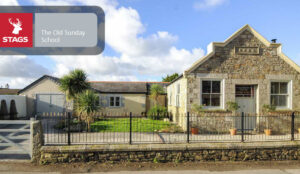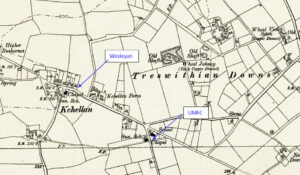This profile of Kehelland UMFC has been compiled by Jo Lewis and Tony Mansell.
Located to the east of the village.
Reportedly built in 1861 with a Sunday school.
It is not on the 1867 list of registered chapels.
There are baptisms and deaths recorded from 1880.
Heritage Gateway: Kehelland United Methodist chapel and associated Sunday school is recorded on the 1st and 2nd Edition 1:2500 1880 and 1907 OS Maps. Shown as a Free United chapel on the 1907 OS Map. The 1999 Cornwall CC Aerial Imagery shows the chapel has gone but the Sunday school survives. By 2005 the Aerial Imagery shows a new dwelling on the site of the chapel. It is probable that the Sunday school has been converted to a dwelling.https://www.heritagegateway.org.uk/Gateway/Results_Single.aspx?uid=MCO52214&resourceID=1020
Heritage Gateway: The Sunday school associated with Kehelland United Methodist chapel is recorded on the 1st and 2nd Edition 1:2500 1880 and 1907 Maps. Whilst the chapel has been demolished the Sunday school survives having been converted into a dwelling. https://www.heritagegateway.org.uk/Gateway/Results_Single.aspx?uid=MCO52215&resourceID=1020
The Chapel had its own Sunday school. There is a building shown on pre-1888 maps next to the chapel which might have been an earlier school.
1906: Tender was agreed for building of a Sunday school and reseating the Chapel.
1907: The Methodist New Connexion, Bible Christians and United Methodist Free Churches amalgamated to become the United Methodist Church.
1907: Became Kehelland United Methodist Church.
1932: The Wesleyan, Primitive Methodist and the United Methodist Church amalgamated to become the Methodist Church of Great Britain.
1932: Became Higher Kehelland Methodist Church (as opposed to Lower Kehelland Methodist Church which was the Wesleyan). It was known as “Top Chapel” by the villagers and there was undoubtedly rivalry between the two.
1936: Chapel renovated. (West Briton and Cornwall Advertiser – Monday 19 October 1936)
1940: Seating for 165. (Revd David Easton)
1956: Closed for worship and the congregation joined the Wesleyan ‘Lower’ Chapel.
The Sunday school building remains.
The chapel has been demolished and replaced by a modern building linked to the Sunday school as the Estate Agent brochure. https://media.onthemarket.com/properties/2392982/doc_0_2.pdf

Further reading:
https://kresenkernow.org/SOAP/search/RelatedNameCode.keyword/CRO%7CUK%7C1236/
David Thomas on Facebook
Leaving the site of the former Wesleyan Methodist chapel at Lower Kehelland behind us (the present Kehelland Methodist Church) we turn back on ourselves and climb the road in an approximate south easterly direction, walking back up through the village to the site of the other village chapel, very close to the village school, but on the other side of the road that leads to the old A30 main road between Camborne and Hayle, at Higher Kehelland. The chapel itself does not stand any longer, though the adjacent later Sunday School building remains, incorporated into a modern dwelling that has been constructed on the site of the demolished chapel building.
We have already noted in our piece on the village’s Wesleyan chapel that numbers of members at that place began to fall away towards the end of the nineteenth century and into the twentieth. This can partly be explained by the collapse of the Cornish mining economy in and after the 1870s, with consequential emigration and population reduction, but not solely for those reasons. The situation at Kehelland followed the pattern of so many other Cornish communities after about 1850, where religious Nonconformist allegiance polarised itself between the established Wesleyans and the post-1849 Wesleyan Reformers, who on a national basis founded the United Methodist Free Church in 1857. In Kehelland, when the local economy was still doing really well, a new United Methodist Free Church was built at this top end of the village in 1861, at a considerable distance from the 1830 Wesleyan chapel. In due course it came to be known as ‘Top Chapel’ by the locals and the term can still be heard occasionally today in local reminiscing conversations. Therefore after 1861 the Wesleyans held sway in the bottom end of the village and the Free Methodists at the upper end.
The Free Methodists in their early years were not particularly adept at keeping baptism records and although the chapel was opened in 1861 the first recorded entry in the chapel’s two surviving baptism registers was not recorded until the year 1880. The last baptism in the building took place in 1955.
The Society at Higher Kehelland was still in an expansionist mood in those golden Edwardian years before World War One and the Redruth archives contain the tender and building agreement for a new Sunday School in 1906, which was duly constructed and still stands today, incorporated into a modern dwelling. Chapel accounts also survive for the period 1896-1956.
Closure of the Higher Kehelland premises came in 1956, 24 years after Methodist Union in 1932. There does not therefore seem to have been any immediate rush to amalgamate the two Kehelland Methodist Societies following that union. They both soldiered on!
Following closure the main chapel building was I believe used for storage. lts pipe organ was rebuilt in a reduced form at the nearby Treswithian chapel, while the wooden pulpit found a home in the thatched chapel at Gwithian. The Higher Kehelland Society therefore had an active life of 95 years and did not attain its Centenary.
In the 1980s it was very noticeable, driving into Kehelland from the direction of Lanvain Farm, that the large gable front of the chapel had developed a pronounced lean inwards, with the building being in a very poor condition. Demolition came later and the site was redeveloped as a residence attached to the 1906 Sunday School.
 This picture shows the surviving 1906 Sunday School which has been well renovated and brought back into use as a home. Its large date stone sits in the gable.
This picture shows the surviving 1906 Sunday School which has been well renovated and brought back into use as a home. Its large date stone sits in the gable.
 This photograph is from the 1920s and from the camera of intrepid roving Pengegon organist cameraman Charles Prisk, who recorded so much for us of our local Methodist heritage that has now vanished. Here’s his interior shot of the main chapel building, showing the pulpit now at Gwithian and the organ which was a product of the Fleetwood organ factory at Carnarthen Row in Camborne. There are also some magnificent oil lamps.
This photograph is from the 1920s and from the camera of intrepid roving Pengegon organist cameraman Charles Prisk, who recorded so much for us of our local Methodist heritage that has now vanished. Here’s his interior shot of the main chapel building, showing the pulpit now at Gwithian and the organ which was a product of the Fleetwood organ factory at Carnarthen Row in Camborne. There are also some magnificent oil lamps.
The Higher Kehelland chapel organ was probably the most visually appealing of all the instruments ever produced by the Fleetwood works between 1884 and 1923. It had a substantial pipe display case and our third photo is an enlargement of picture two, showing the detail of the case. The pipes had gold speaking mouths with highly decorative coloured stencilled work. It was a great pity that when the organ went to Treswithian after 1956 in a reduced form, with the two side wings of the display case being removed, all of this ornate decoration was erased. Prisk’s picture is therefore an important record of departed glories! If only it was in colour!

 Map:
Map:
Good Morning to you,
My name is Glynis Millett-Clay (Nee Cock), I have just discovered that the pews in the Kehelland Chapel were removed and on the one was an inscription “W.J. COCK”. I believe this could be either my gt grandfather William John Cock or his son William James Cock – my grandfather. Please let me know if you have any information or detail on WJ Cock that were members of your Church in late 1890’s and early 1900’s. I have a reward book signed by W.J. Cock, my gt grandfather as the Superintendent at the Camborne Bible Christian Sunday School.
No information I’m afraid Glynis.